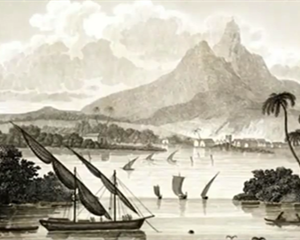There was the soil, so fertile it could support three harvests a year.
那里的土壤非常肥沃,一年可以收割三次。
There were the riverbeds, where lumps of gold lay along the banks.
那里有河床,岸边有金块。
And there was the fact that, uniquely for Central America, Poyais had no tropical diseases.
而且,波亚斯没有热带疾病,这在中美洲是独一无二的。
Trust us, that last one will soon seem bitterly ironic.
相信我,最后一条很快就会非常讽刺。
But why did MacGregor go to all this trouble to invent a fake country? For an answer to that, you need to look to London's Scottish communities.
但是为什么麦格雷格尔要费这么大的劲去创造一个虚假的国家呢?想要找到答案,你需要去看一下伦敦的苏格兰社区。
That same summer, the Poyais envoy began visiting them. He was offering them an opportunity, he said.
同年夏天,波亚斯特使开始拜访他们。他说自己是在给他们提供一个机会。
An opportunity not just to better their own lives by moving to Poyais, but an opportunity to establish Scotland's first viable colony.
他们不仅有机会通过搬到波亚斯来改善自己的生活,而且有机会建立苏格兰第一个可行的殖民地。
A chance to make their country into a global player.
这是一个让他们的国家成为全球参与者的机会。
All they had to do, Gregor MacGregor told his fellow Scots, was to buy one of these plots of Poyais land he was selling. Fertile land that would set them for life.
格雷戈·麦格雷格尔告诉他的苏格兰同胞们,他们所要做的就是买一块他要出售的波亚斯土地,那里肥沃的土地可以供他们生活。
Faced with such an offer, who could refuse?
面对这样的提议,谁能拒绝呢?
The Bubble By the fall of 1822, interest in Poyais was running rampant.
到了1822年的秋天,人们对波亚斯的兴趣开始高涨。
The first boatload of Scottish settlers had just departed for the country, and a general bubble in Latin American securities was expanding.
当第一批苏格兰移民刚刚启程前往这个国家之时,拉丁美洲证券市场的泡沫正在扩大。
So when MacGregor asked a bank to underwrite Poyais bonds, they simply nodded and handed him £200,000.
因此,当麦格雷格尔要求一家银行为波亚斯债券承保时,银行直接就点头同意了,给了他20万英镑。
Using that money, MacGregor opened Poyais consulates across Britain, adding to the scheme's veneer of legitimacy.
麦格雷格尔用这笔钱在英国各地开设了波亚斯领事馆,增加了该计划的合法性。
For MacGregor, these were the salad days; a phrase which means the heyday of something, which is an odd choice when you consider how boring salad is.
对麦格雷格尔来说那些都是青春年少的日子。“salad days”这个短语说的是某事物的鼎盛时期,当你想到沙拉(salad)有多无趣时用这个词会很奇怪。
By winter, investment in Poyais bonds had generated over a billion pounds in today's money. And MacGregor was still selling land to gullible Scots!
到了冬天,对波亚斯债券的投资已经产生了相当于今天的10亿英镑的收益,而此时麦格雷格尔还在把土地卖给那些轻信于人的苏格兰人!
The second boat of settlers departed in January, 1823.
第二艘移民船于1823年1月启程。

But there's one problem with dispatching boatloads of settlers to a non-existent country. What do you do when they finally arrive?
不过,把一船又一船的移民送到一个不存在的国家有一个问题:等他们到那之后怎么办?
Well, let's find out.
嗯,咱们接着看。
In November, 1822, the first ship reached the Mosquito Shore.
1822年11月,第一艘船抵达了蚊子海岸。
As the boat approached land, the Scottish settlers all donned their fanciest outfits, and fired the gun so a Poyais boat would come out and guide them to the capital.
当船接近陆地时,苏格兰殖民者都穿上了他们最华丽的衣服,并鸣枪示意波亚斯的船出来引导他们前往首都。
Instead, the gunshot echoed across the empty waters and mangrove swamps, answered only by deafening silence.
然而呢,枪声在空旷的水面和红树林沼泽中不断地回响,而回应他们的只有震耳欲聋的寂静。
At first, the settlers assumed they must've made a navigation error.
一开始移民们以为他们一定是搞错了。
So they all had their stuff unloaded onto a deserted stretch of coast, and sent the captain off to find Poyais.
所以他们都把自己的东西卸到了一片荒芜的海岸上,然后派船长去找波亚斯。
It's worth noting that these were not young, hardy types desperate for adventure.
值得说明的是,这些来到这里的人都不是渴望冒险的年轻、健壮的人。
Most of those caught up in the Poyais scheme were older folks looking for an easy retirement, or families with young children.
大多数参与波亚斯计划的人都是寻求安逸退休生活的老年人,或者有小孩的家庭。
Surviving on a deserted stretch of tropical shore was definitely not within their skillset.
在荒芜的热带海岸上生存绝对不在他们的能力范围内。
In March, 1823, the second ship joined the stranded settlers.
1823年3月,第二艘定居者的船也陷入了困境。
Incredibly, everyone still assumed their navigation was off.
令人难以置信的是,大家都认为是他们的导航没有打开。
Even when the captain of the first ship returned and said "so, I've sailed all up and down this coast and there's no Poyais,"
甚至当第一艘船的船长回来时,他说:“我已经在这个海岸上上上下下航行过了,没有波亚斯,”
they told him, "err, obviously there is. Duh. Try again." So off the captain went again.
然而他们告诉他,“呃,波亚斯肯定是有的,咄,再试一次吧。”于是船长又出发了。
And the now hundreds-strong crowd of settlers settled down to wait again.
现在已经有数百名定居者定居下来并再次等待。
That same month, a hurricane battered the Mosquito Shore, destroying supplies, and wrecking the remaining ship.
同月,一场飓风袭击了蚊子海岸,摧毁了补给,并摧毁了剩下的船只。
Then the rains came. Thick, heavy, endless rains that left the settlers soaked. Finally, in the wake of the rains, came the mosquitoes.
后来又下起了雨,连绵不断的暴雨把移民们淋得浑身湿透。最后大雨过后,蚊子来了。
If you've ever been to the tropics in rainy season, you'll have seen just how thick the air can get with mosquitoes carrying yellow fever and malaria.
如果你去过热带地区的雨季,你就知道携带黄热病和疟疾的蚊子能使空气变得多厚重。
On the deserted shore, the insects mobbed the unprepared settlers, biting them, infecting them.
在荒无人烟的海岸上,昆虫包围了这些毫无准备的定居者,咬他们,感染他们。
One by one, the abandoned Scots began to die. Babies passed away in their mothers' arms. Elderly women died, wracked with malaria.
被抛弃的苏格兰人开始一个接一个地死去,婴儿死在母亲的怀里,老年妇女死于疟疾。
Of the 200 or so Poyais settlers who reached the Mosquito Shore, it's estimated over two thirds were killed by tropical diseases.
在抵达蚊子海岸的200多名波亚斯定居者中,据估计有超过三分之二的人死于热带疾病。
It was a massacre by neglect. A death sentence as sure as a firing squad.
这是一场因疏忽而造成的大屠杀,死刑就像行刑队一样确定无疑。
The only reason anyone survived is because a ship from British Honduras just happened to pass and alert the colonial authorities.
有幸存者的唯一原因就是因为有一艘来自英属洪都拉斯的船碰巧经过并通知了殖民当局。
For the rest of 1823, the Royal Navy was overwhelmed evacuating the survivors and intercepting ships headed for Poyais.
在1823年剩下的时间里,皇家海军忙于疏散幸存者和拦截前往波亚斯的船只。
By the year's end, they'd stopped five more settler ships, each carrying hundreds of people.
到年底,他们又拦截了五艘移民船,每艘船上都载有数百人。
Had they reached the Mosquito Shore, it's likely the death toll of the Poyais scheme would've topped a thousand.
如果他们都到达了蚊子海岸,那么波亚斯计划的死亡人数可能会超过1000人。
Back in London, news of the disaster first broke in October, 1823.
咱们再回到伦敦,1823年10月,灾难的消息首次传出。











